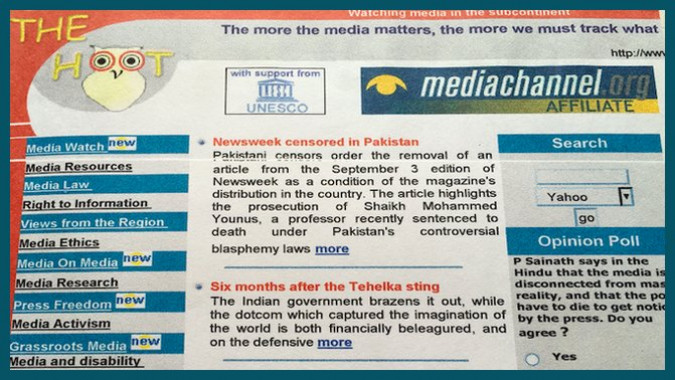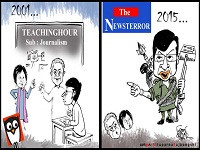2001-2018—what The Hoot’s long haul captured
The Hoot homepage in 2001
India’s media landscape has seen both steady and transformative change since the Hoot was founded in 2001.
An archive than can offer perspective over the entire 21stcentury period can do the following: it can show you what self censorship looked like in 2005, and then in 2013 in contrast to today. Or document a period when both MJ Akbar and Zee News were critics of an NDA government. The Asian Age under MJ Akbar back in 2002 was taking on the Atal Bihari Vajapayee PMO. Today he is a minister in the NDA II government. The same story shows how Zee News gleefully bought footage of an early Tehelka sting and showing raw footage from Operation West End across its 15 channels. Today it would consider such behavior high treason.
At that time, believe it or not, Subhash Chandra’s Zee was considering buying a stake in Tehelka!
Our archive captures a long span of advertising-related issues over the years from sponsored news, to paid news to Private Treaties innovated by the Time Group in 2008, a service which it then began to advertise on its pages in 2009! Intrusive advertising took the shape of an ONGC pipeline snaking across news pages or tyre ads cutting across news stories, and then advertising turned to newsmaking with surveys sponsored by Gillette on how many women were turned off by unshaven men.
The long trajectory of government advertising allocation politics by state and central governments starting from the years of NDA I is to be found here, as are the many innovations in election-time paid news. In 2010 Dainik Bhaskar in Haryana was carrying paid news in Hindi and declaring it in tiny letters in English.
But let us note that some virtuous self correction has also crept in. Back in 2002 advertising supplements were not clearly labeled as such, either in the English press or in Hindi publications. Today in a trend begun by Mint, newspapers carry little boxes telling you that a yellow or red initiative is an advertisement and should be treated as such.
As for public relations, we documented the upheaval caused by the Radia Tapes in 2010 and almost two years later, this brilliant series showed how to spot the astro turf on newspapers and TV channels. From covering conflict to reporting on terror or environment or business or rape, the many challenges of 21stcentury journalism in India are encapsulated here.
Beginning from 2002, after the Gujarat riots, communalism as covered by the media is found here. What’s more, the developing of discernable communal intent of sections of the press and TV becomes traceable. But on this as on all issues, the counter-narrative to that of the liberal left has always found place on this site, beginning with a journalist’s investigation of what actually happened at Godhra, to the tendency to sensationalise and communalise any news relating to Gujarat in the years following, to whether media bias suggested that there were good rioters and bad rioters in the coverage of the 2014 Saharanpur riots.
In 2002 Chandra Bhan Prasad was asking, where are the Dalit journalists, repeating a question first asked in 1996 in the Pioneer. While this question recurs on The Hoot’s pages in 2003, and in a series carried in 2013, the issue of caste in media is examined over the years through many dimensions, one of those being the reporting on Mayawati and Kanshi Ram. There is also the issue of casteist reporting which crops up again and again, as does invisibility of dalit issues in the media. But by 2016 dalits were creating their own media, And the supreme irony in 2018 was that the government of India was issuing an advisory to television channels against the use of the word dalit!
On a lighter note, when the Hoot turned 15 in March 2016 it captured what had changed over the years. We are adding in parenthesis, a post script to some of those pointers.
- Arnab Goswami has gone from playing second fiddle to Barkha Dutt and Rajdeep Sardesai on NDTV, to being the Terror of Prime Time News with whom they struggle to compete. (Today he too, has competition, and Dutt is missing in action.)
- Swapan Dasgupta has gone from being CM Modi’s earthquake rehabilitation chronicler to PM Modi’s weekly defender in the Pioneer. (And now in 2018 to becoming a Rajya Sabha MP, while still being his weekly defender.)
- Raghav Bahl transitioned from a cashless media empire to lots of cash and very little empire. (But is now building one with Quint.)
- Tehelka began as an enfant terrible which reinvented media investigation ethics and foundered more than a decade later after Tarun Tejpal reinvented office ethics.
- The Times Group transitioned from notoriety for espousing paid news in 2004 to notoriety for professing to be in the advertising business in 2012.
- NDTV went from English news supremacy in 2001 to operating losses a decade later. And to being hounded by government investigators after Narendra Modi became prime minister.
- The Hindu tumbled through three family coups and returned to N Ram’s invisible hold.
- From being Shekhar Gupta’s paper The Indian Express went back to being the Goenkas’ paper.
- Digital media brands have less evocative titles now. We’ve gone from Tehelka, to the more prosaic Catch, Quint, Scroll, Wire and The Print.
- Journalists have gone from being financed by the Ambanis, to being employed by their expanding media empire.
- In 2001 Video had not replaced text, YouTube was not on the horizon and only birds tweeted. By 2016 Twitter had become the film star’s and politician’s best friend and hacks could live off readymade news. Apart from promoting their own work on it.
- Facebook has gone from being a social media platform to a publishing behemoth.
- Free Speech has gone from being taken for granted to something that you are now accused of unreasonably demanding.
- Left-liberal journalism is rapidly ceding ground and respectability to right wing journalism.
- PR evolved. By 2002 PR companies were already helping people get into the news, or stay out of the news, and blocking direct access to corporate honchos.
- By 2010 the Radia tapes told us how the good lady was teaching her flock to differentiate between what journalists needed and what proprietors needed and to supply both.
- From the Talwars to Tarun Tejpal to Indrani Mukherjea media trials multiplied, and TV channels prospered, even as a Delhi High Court bench admittedin 2015 that media trials do influence judges and affect trials.
There is more madness than method on what you will find on the Hoot. It never did have its own reporters, so what came is what we used. But once the space was created, willy nilly it captured what had not been captured before. Overall, therefore, this is a that’s-the way-it-turned-out web resource. Some states have sections devoted to them, other states don’t, because contributors on media watch emerged in some states, and did not in others.
Even so the platform collected writing that sheds light on the rapid transformation of the media landscape. Some matter has been lost over the years, some incomplete items have been left in if they offer an useful hint of something significant that happened. And for reasons of relevance some articles feature in more than one section.
Kashmir has turned out to be our heaviest section by far, and tells us that back in 2002 STD and Internet censorship were still a plague on the state. It takes a researcher through the harrowing reality of practicing journalism here, the digital censorship and the many vagaries of the media business in the state. The Hoot’s earliest Kashmir inputs came courtesy Shujaat Bukhari, the Rising Kashmir editor assassinated earlier this year.
The Hoot archive also presents possibly the first database of media judgements--related to free speech, both in the High Court and Supreme Court.
In a country which has voluminous media and needs to have full-fledged media research centres, we hope our archive will provide a starting point.
Sevanti Ninan was founding editor of the Hoot









